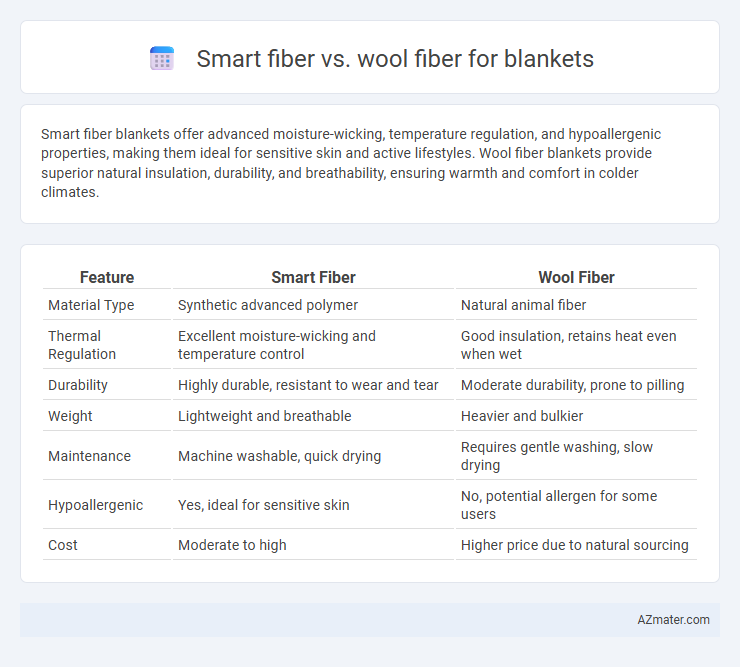Smart fiber blankets offer advanced moisture-wicking, temperature regulation, and hypoallergenic properties, making them ideal for sensitive skin and active lifestyles. Wool fiber blankets provide superior natural insulation, durability, and breathability, ensuring warmth and comfort in colder climates.
Table of Comparison
| Feature | Smart Fiber | Wool Fiber |
|---|---|---|
| Material Type | Synthetic advanced polymer | Natural animal fiber |
| Thermal Regulation | Excellent moisture-wicking and temperature control | Good insulation, retains heat even when wet |
| Durability | Highly durable, resistant to wear and tear | Moderate durability, prone to pilling |
| Weight | Lightweight and breathable | Heavier and bulkier |
| Maintenance | Machine washable, quick drying | Requires gentle washing, slow drying |
| Hypoallergenic | Yes, ideal for sensitive skin | No, potential allergen for some users |
| Cost | Moderate to high | Higher price due to natural sourcing |
Introduction to Smart Fiber and Wool Fiber
Smart fiber, a technologically advanced synthetic material, offers moisture-wicking, temperature regulation, and enhanced durability, making it ideal for modern blankets. Wool fiber, sourced from sheep, provides natural insulation, breathability, and excellent thermal regulation, ensuring warmth and comfort in colder climates. Choosing between smart fiber and wool fiber depends on preferences for sustainability and performance features.
Key Differences Between Smart Fiber and Wool
Smart fiber blankets offer superior moisture-wicking properties, making them ideal for regulating body temperature and staying dry, while wool fiber excels in natural insulation and breathability due to its lanolin content. Wool fibers provide excellent odor resistance and durability, maintaining warmth even when damp, whereas smart fibers often incorporate synthetic materials engineered for enhanced softness and allergy resistance. The maintenance of smart fiber blankets typically involves easier machine washing without shrinkage, unlike wool which requires delicate care to preserve its natural fibers.
Thermal Insulation Properties Compared
Smart fibers exhibit superior thermal insulation properties compared to traditional wool fibers due to their ability to regulate temperature through moisture-wicking and enhanced breathability. Wool fibers naturally trap air within their crimped structure, providing excellent warmth retention but can become less effective when wet. Smart fiber blankets maintain consistent insulation even in variable humidity, making them ideal for active or fluctuating environments.
Moisture Management and Breathability
Smart fiber blankets offer superior moisture management due to their advanced synthetic materials that wick moisture away from the skin, keeping users dry and comfortable. Wool fiber blankets naturally excel in breathability with their porous structure, allowing air to circulate and regulate temperature effectively, while also absorbing moisture without feeling damp. Choosing between smart fiber and wool fiber hinges on the balance of moisture-wicking technology and natural airflow for optimal blanket comfort.
Durability and Longevity of Blankets
Smart fibers, often engineered with synthetic blends, offer superior durability and resistance to wear compared to traditional wool fibers, making blankets more resilient to daily use and washing. Wool fibers provide natural elasticity and warmth but tend to experience pilling and fiber breakage over time, reducing blanket longevity. Blankets made from smart fibers maintain structural integrity longer, ensuring sustained comfort and durability in high-traffic environments.
Hypoallergenic Qualities and Skin Friendliness
Smart fibers used in blankets often feature advanced hypoallergenic properties that resist dust mites, mold, and allergens, making them ideal for sensitive skin and allergy sufferers. Wool fibers, while natural and breathable, can sometimes cause irritation or itchiness due to lanolin content and coarse texture, although fine merino wool offers improved softness and skin compatibility. Choosing smart fiber blankets ensures enhanced skin friendliness through moisture-wicking and antimicrobial treatments, providing a comfortable and irritation-free sleep environment.
Sustainability: Eco-Impact of Each Fiber
Smart fiber blankets, often made from recycled or bio-based materials, offer enhanced sustainability through reduced water consumption and lower carbon footprints compared to traditional wool fibers. Wool fiber, while renewable and biodegradable, involves higher resource inputs such as significant land use and methane emissions from sheep farming, impacting its eco-profile. Choosing smart fiber blankets supports eco-conscious consumers seeking durable, low-impact textiles with minimized environmental degradation.
Care, Cleaning, and Maintenance
Smart fiber blankets offer superior ease of care compared to wool, as they are typically machine washable and resistant to shrinking and wrinkling. Wool fiber requires gentle hand washing or dry cleaning to maintain texture and avoid felting, making its upkeep more labor-intensive and costly. The durability and stain resistance of smart fibers reduce maintenance time, while wool guarantees natural breathability and warmth but demands more delicate handling.
Price Comparison and Value for Money
Smart fiber blankets generally cost less than wool fiber ones, making them a budget-friendly option for consumers seeking warmth without high expense. Wool fiber offers natural insulation and durability, which can justify its higher price through long-term use and greater comfort. Choosing smart fiber blankets provides immediate savings, while wool fibers deliver enhanced value for money through sustained performance and natural properties.
Conclusion: Choosing the Right Fiber for Your Blanket
Smart fiber blankets offer superior moisture-wicking, durability, and hypoallergenic properties, making them ideal for allergy sufferers and active individuals. Wool fiber blankets provide excellent warmth, natural breathability, and eco-friendly benefits, suitable for cold climates and those seeking traditional comfort. Selecting the right fiber depends on your specific needs for temperature regulation, maintenance, and environmental impact.

Infographic: Smart fiber vs Wool fiber for Blanket
 azmater.com
azmater.com